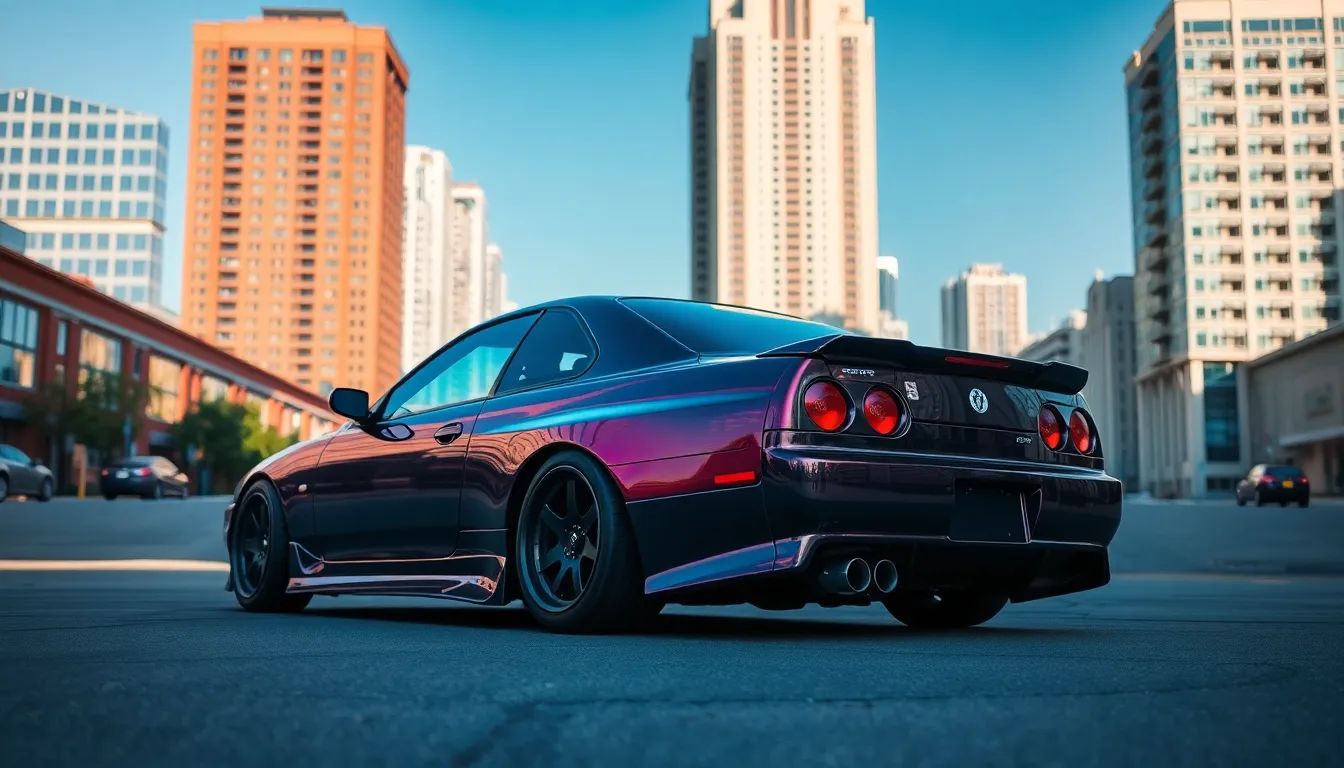We’ve all been captivated by that unmistakable JDM aesthetic – the sleek lines of a Nissan Skyline GT-R cutting through neon-lit Tokyo streets or the aggressive stance of a lowered Honda Civic Type R. There’s something magnetic about Japanese Domestic Market cars that goes far beyond their impressive performance capabilities.
The JDM aesthetic isn’t just about flashy modifications or cherry blossom decals. It’s a carefully curated visual philosophy that blends form with function creating machines that look as good as they perform. From the iconic pop-up headlights of the Mazda RX-7 to the distinctive rear spoilers that have become synonymous with Japanese tuning culture we’re talking about a design language that’s influenced automotive enthusiasts worldwide.
What makes JDM cars so visually appealing? We’ll explore the key elements that define this aesthetic from authentic styling cues to the subtle details that separate genuine JDM appeal from mere imitation.
Understanding the JDM Cars Aesthetic Philosophy
We’ve established how JDM styling captivates enthusiasts worldwide, but understanding its deeper philosophy reveals why these designs remain timelessly appealing.
Origins in Japanese Car Culture
Japan’s automotive aesthetic emerged from the country’s manufacturing philosophy of kaizen, which emphasizes continuous improvement and perfection. We see this reflected in how Japanese manufacturers approached car design during the 1980s and 1990s, prioritizing clean lines over excessive ornamentation. Cultural influences from traditional Japanese arts like wabi-sabi shaped the industry’s preference for understated beauty and functional simplicity.
Racing heritage played a crucial role in defining authentic JDM aesthetics. Cars like the Nissan Skyline GT-R and Honda NSX developed their iconic appearances through motorsport requirements rather than marketing departments. We observe how track-tested aerodynamic elements became signature styling cues that enthusiasts still celebrate today.
Minimalist Design Principles
Japanese designers embraced the “less is more” philosophy long before it became a global trend. We notice how authentic JDM cars feature purposeful body lines that serve aerodynamic functions while creating visual appeal. Elements like the Toyota Supra’s smooth roofline or the Mitsubishi Lancer Evolution’s subtle fender flares demonstrate restraint in execution.
Color choices traditionally favored monochromatic schemes with occasional accent pieces. Championship White on Honda Civics or Bayside Blue on Nissan Skylines became legendary not through flashiness but through their ability to highlight the car’s natural proportions. We see how these restrained palettes allow the vehicle’s architecture to speak for itself.
Function Meets Form Approach
Every aesthetic element in authentic JDM design serves a practical purpose beyond visual impact. We examine how front splitters reduce lift, side skirts manage airflow, and rear wings generate downforce while creating the distinctive JDM silhouette. This integration of performance and appearance sets genuine JDM styling apart from purely cosmetic modifications.
Interior design follows the same philosophy, with driver-focused layouts that prioritize usability. Dashboard designs like those in the Honda S2000 or Mazda RX-7 place controls within easy reach while maintaining clean, uncluttered surfaces. We appreciate how these cockpits reflect Japanese attention to detail and ergonomic efficiency.
Weight reduction influenced aesthetic choices throughout JDM car development. Manufacturers used lightweight materials and eliminated unnecessary trim pieces, creating the lean, purposeful appearance that defines the aesthetic today. We recognize how this practical approach to design created an unintentionally beautiful visual language that continues to inspire modern builds.
Iconic JDM Body Styles That Define the Aesthetic
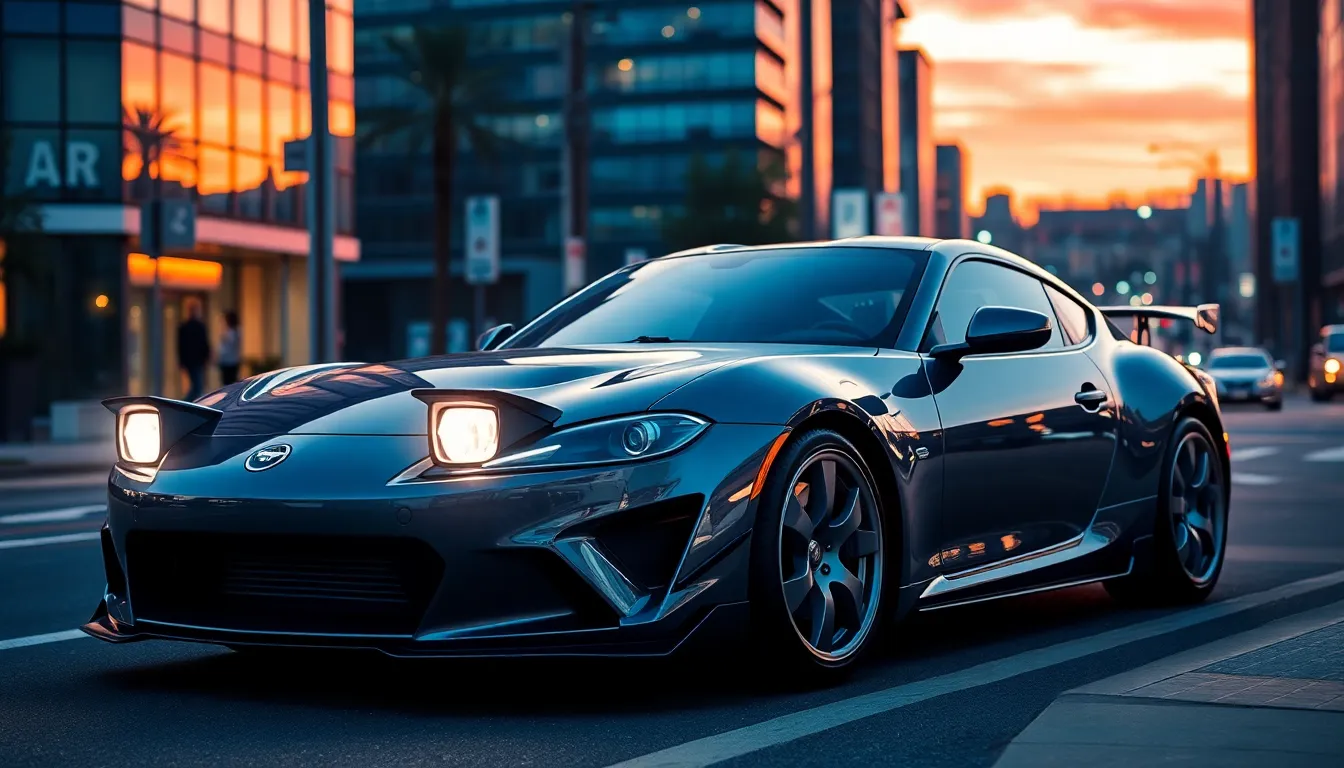
Three distinct body styles became the foundation of JDM car aesthetic, each contributing unique visual elements that continue to influence automotive design worldwide.
Lightweight Sports Coupes
Sports coupes represent the pinnacle of JDM aesthetic philosophy through their perfect balance of performance and visual appeal. Models like the Toyota AE86, Nissan 240SX, and Mazda RX-7 showcase the classic wedge profile that defines this category. Long hoods stretch toward compact passenger compartments, creating proportions that emphasize the rear-wheel-drive layout beneath.
Pop-up headlights became the signature feature of many iconic sports coupes from this era, including the Mazda RX-7 FC and FD generations. These retractable lights contributed to the clean nose design while closed and added dramatic flair when opened. The Toyota Supra A70 and A80 models demonstrate how fixed headlights could achieve similar visual impact through integrated design.
Wide rear haunches and muscular wheel arches define the aggressive stance that enthusiasts associate with authentic JDM sports coupes. The Nissan 300ZX Z32 exemplifies this design language with its broad shoulders and tapered cabin. Functional aerodynamic elements like front air dams and rear spoilers enhance both performance and visual drama without appearing overdone.
Compact Hot Hatches
Hot hatches brought JDM aesthetic to everyday practicality while maintaining the performance focus that defines the movement. The Honda Civic hatchback generations from the late 1980s and early 1990s established the template with their boxy yet purposeful shapes. Clean lines and minimal ornamentation allowed the natural proportions to create visual interest.
Aggressive wheel fitments became the defining modification for JDM hot hatches, with owners pursuing the perfect balance between form and function. Models like the Toyota Starlet and Nissan Pulsar GTi-R showcase how wide wheels and lowered suspension transform compact dimensions into striking street presence. The stance culture that emerged from this aesthetic continues to influence builds today.
Functional vents and scoops integrated seamlessly into the bodywork of performance oriented hot hatches. The Subaru WRX STi hatch demonstrates how cooling ducts and brake vents can enhance both performance and visual appeal. These elements never appeared purely decorative but served genuine functional purposes while contributing to the overall design language.
Sleek Sedan Silhouettes
Four door sedans achieved JDM aesthetic through sophisticated proportions rather than flashy modifications or excessive styling cues. The Nissan Skyline GT-R R32, R33, and R34 generations exemplify how boxy yet refined shapes can create timeless appeal. Their understated aggression comes from subtle flares and purposeful aerodynamic additions.
Low rooflines and extended wheelbases characterize the most desirable JDM sedans, creating elegant profiles that emphasize speed even when stationary. The Toyota Crown and Nissan Cefiro showcase how luxury sedans incorporated performance aesthetics without compromising sophistication. These proportions influenced the VIP car movement that emerged in the following decades.
Discrete performance modifications distinguish authentic JDM sedans from their more ostentatious counterparts. Models like the Honda Accord Type R and Toyota Chaser demonstrate how functional upgrades like bigger brakes and suspension components can enhance appearance while improving capability. The result creates vehicles that appear refined to casual observers but reveal their performance intentions to knowledgeable enthusiasts.
Essential Visual Elements of JDM Cars Aesthetic
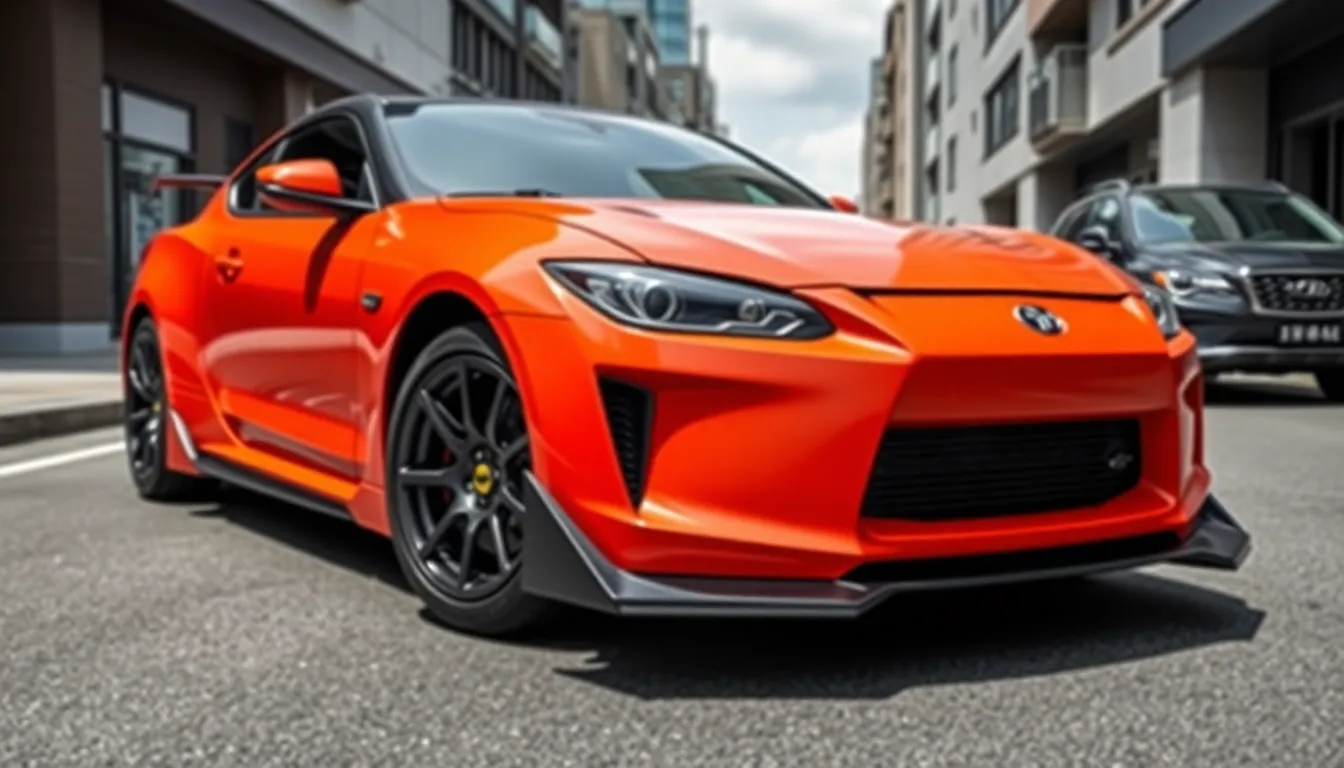
We recognize that authentic JDM styling relies on exact visual components that work together to create the unmistakable aesthetic. These fundamental elements distinguish genuine Japanese domestic market cars from their international counterparts.
Clean Lines and Angular Geometry
Sharp bodywork defines the foundation of every authentic JDM aesthetic build. We observe how Japanese designers prioritize geometric precision over flowing curves, creating vehicles that appear carved from single blocks of metal. Angular fender flares on models like the Toyota AE86 and Nissan Silvia S13 showcase this philosophy perfectly.
Straight body panels eliminate unnecessary complexity while emphasizing the car’s core proportions. Design teams focused on creating visual tension through contrasting angles rather than smooth transitions. Door handles, window frames, and body seams follow strict geometric patterns that reinforce the overall angular theme.
Razor sharp character lines run from headlight to taillight, creating shadow play that changes throughout the day. These deliberate creases serve both aesthetic and aerodynamic purposes, directing airflow while maintaining visual interest. Factory designers understood that aggressive geometry could enhance performance without compromising the clean aesthetic principles.
Aggressive Front Splitters and Spoilers
Functional aerodynamic elements separate authentic JDM builds from superficial modifications. We see how front splitters on cars like the Honda NSX Type R and Nissan Skyline GT-R extend aggressively forward, creating downforce while maintaining visual balance. These components originated from motorsport requirements rather than styling exercises.
Carbon fiber construction dominates high performance applications, providing strength while reducing weight. Material choices reflect the Japanese obsession with purposeful engineering, where every component must justify its existence through function. Splitter designs integrate seamlessly with factory bumper lines, appearing as natural extensions rather than aftermarket additions.
Rear spoilers follow similar functional principles, with designs like the famous Nissan GT-R whale tail serving both aerodynamic and visual purposes. Height and angle specifications come from wind tunnel testing rather than aesthetic preferences. Factory teams balanced downforce generation with the clean lines philosophy, creating spoilers that enhance rather than dominate the overall silhouette.
Distinctive Headlight Configurations
Pop-up headlights represent the most iconic JDM aesthetic element, transforming ordinary cars into design legends. We admire how models like the Mazda RX-7 FD and Honda NSX use these mechanisms to maintain clean daytime profiles while providing excellent nighttime visibility. Engineering teams solved functional lighting requirements through innovative mechanical answers.
Fixed headlight designs emphasize geometric shapes over organic curves, with rectangular and square configurations dominating the industry. Toyota Corolla AE86 and Nissan 240SX feature angular housings that complement their overall geometric themes. Lens designs prioritize clarity and purposeful appearance over decorative elements.
Integrated daytime running lights appeared years before becoming mandatory safety features, with Japanese manufacturers incorporating subtle LED strips into headlight assemblies. These elements provide modern functionality while respecting traditional design principles. Housing materials use lightweight plastics and metals that maintain structural integrity under performance conditions.
Popular JDM Wheel and Stance Modifications
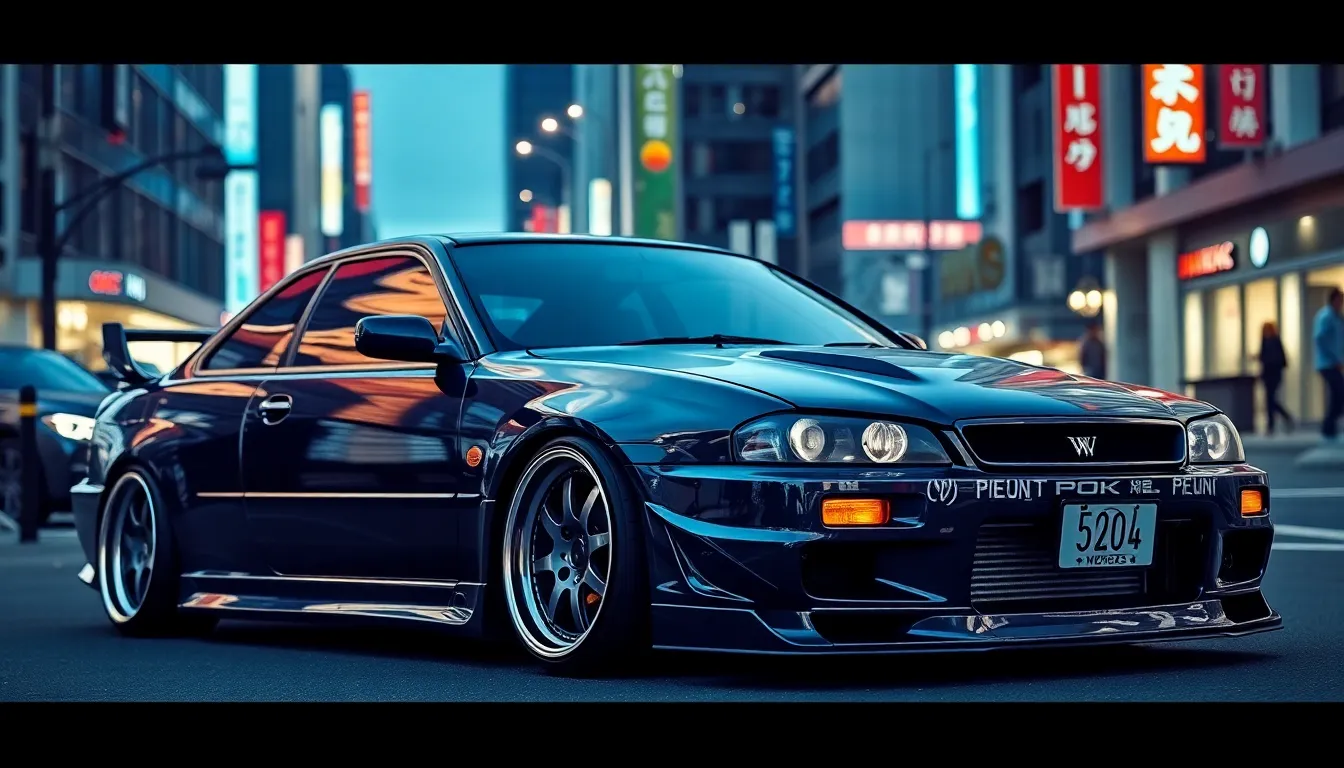
Wheel and stance modifications transform the visual impact of JDM cars more dramatically than any other single modification. These changes create the aggressive, purposeful appearance that defines authentic JDM aesthetic.
Classic Japanese Wheel Brands
Work wheels represent the pinnacle of Japanese wheel engineering, with their Meister S1 and Emotion series becoming synonymous with JDM builds. Racing heritage drives every design decision at Work, creating lightweight forged wheels that deliver both performance and visual appeal. BBS collaboration with Work produced some of the most sought after designs in JDM culture.
Rays Engineering revolutionized wheel technology with their Volk Racing TE37 model, which became the gold standard for track focused builds. These wheels feature distinctive spoke designs that reduce weight while maintaining structural integrity. Gram Lights under the Rays umbrella offers more affordable options without sacrificing the authentic Japanese aesthetic.
Enkei provides accessible entry points into Japanese wheel culture with their RPF1 and NT03 series. Budget conscious enthusiasts gravitate toward Enkei because they offer genuine Japanese manufacturing at competitive prices. SSR wheels like the Type C and Professor series showcase the refined elegance that Japanese designers perfect.
Advan racing wheels dominate professional motorsport, with their TC4 and RZ models appearing on championship winning cars. Street enthusiasts choose Advan for their proven track record and distinctive designs. Spoon Sports wheels represent the ultimate in Honda exact applications, engineered specifically for lightweight performance.
Lowered Suspension Setups
Coilover systems provide the foundation for proper JDM stance, allowing precise height and damping adjustments across all four corners. Japanese brands like Tein, Tanabe, and KW develop suspension specifically for popular JDM chassis. Air suspension offers the ultimate in adjustability, letting owners achieve extreme low ride heights for shows while maintaining drivability.
Static drops using lowering springs create the classic JDM look without the complexity of full coilover systems. Eibach and H&R springs provide reliable answers for enthusiasts seeking moderate drops of 1.5 to 2 inches. Progressive spring rates ensure comfortable daily driving while achieving the desired visual stance.
Adjustable dampers allow fine tuning of suspension characteristics to match wheel and tire combinations. Bilstein and Koni offer rebuild able options that last for decades with proper maintenance. Pillow ball mounts replace rubber bushings for more precise suspension geometry and increased feedback.
Helper springs prevent coil binding when achieving extreme low ride heights popular in JDM culture. These small springs maintain proper coilover function even at minimum height settings. Bump stops require careful attention to prevent suspension damage during aggressive lowering modifications.
Camber and Fitment Culture
Aggressive camber angles create the distinctive tilted wheel appearance that defines modern JDM stance culture. Drift cars typically run 3 to 5 degrees of negative camber for improved tire contact during sideways driving. Show cars often exceed 10 degrees of camber for maximum visual impact, sacrificing practicality for aesthetic appeal.
Stretched tires complement aggressive camber by creating clean wheel lip exposure and emphasizing wheel design. Popular tire sizes like 215/40 on 9 inch wheels create the stretched sidewall look that JDM enthusiasts pursue. Proper sizing requires careful calculation to avoid dangerous stretching that compromises tire integrity.
Flush fitment positions wheels perfectly even with fender edges, creating seamless body to wheel transitions. This technique requires precise offset calculations and often involves fender modifications for clearance. Poke describes wheels extending slightly beyond fenders, creating an aggressive appearance popular in certain JDM subcultures.
Fender modifications become necessary when pursuing extreme fitment with wide wheels and low ride heights. Rolling fender lips provides additional clearance without cutting metal. Pulling fenders creates more dramatic wheel well openings but requires professional execution to maintain structural integrity.
Spacers and adapters fine tune wheel positioning when perfect offset wheels aren’t available. Quality units from companies like Ichiba and H&R ensure safe installation with proper hub centric fits. Extended studs accommodate thick spacers while maintaining proper thread engagement for wheel security.
Signature JDM Paint Schemes and Color Palettes
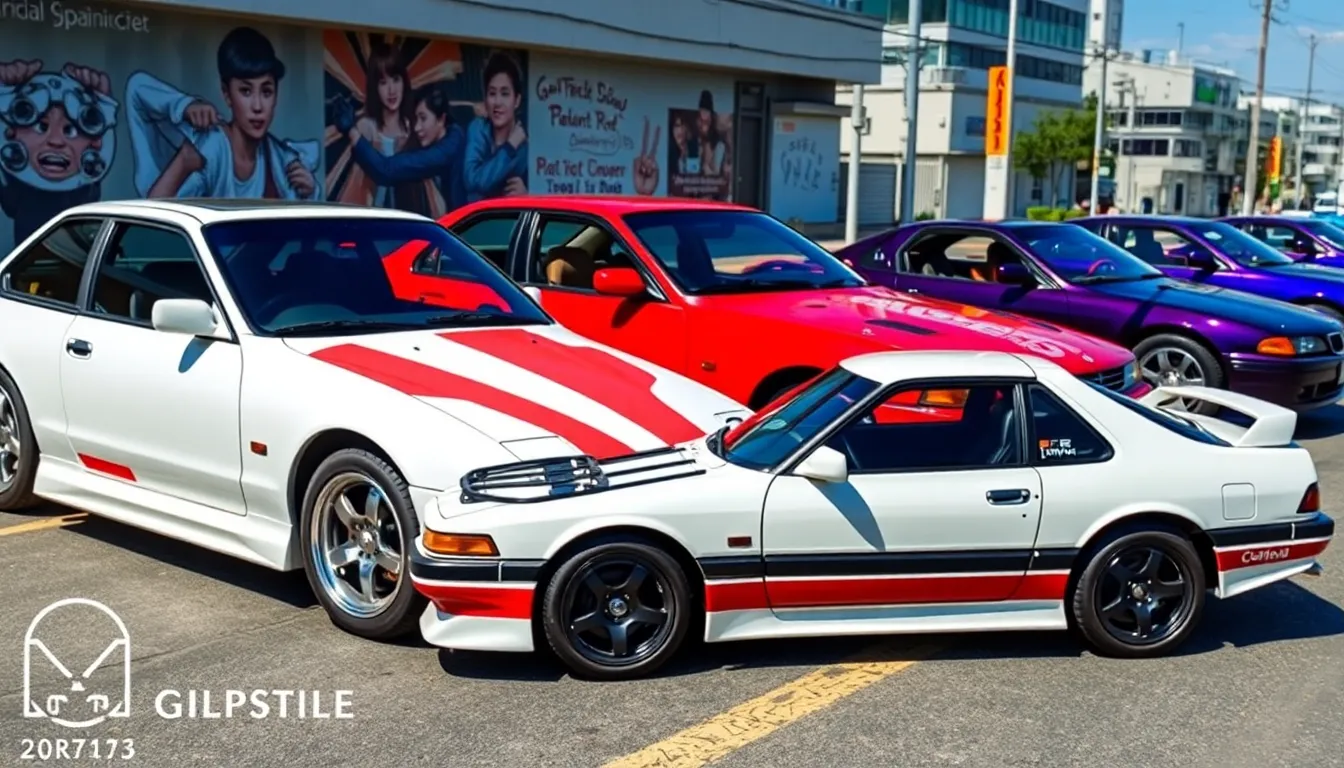
Japanese manufacturers established their legendary status through distinctive color choices that became synonymous with performance and racing heritage. These carefully selected paint schemes continue to influence JDM enthusiasts worldwide.
Championship White and Racing Colors
Championship White dominates JDM racing heritage as the most iconic color choice across multiple manufacturers. Honda first introduced this pristine white finish on the legendary NSX-R, creating an instant connection between track performance and visual purity. Nissan adopted similar white schemes for their GT-R variants, while Toyota featured championship white on performance models like the Supra and AE86.
Racing red serves as another cornerstone of authentic JDM aesthetics, particularly on Honda’s Type R lineup and Mazda’s rotary-powered vehicles. Manufacturers chose these bold reds to signify high-performance variants, with each brand developing their own distinctive shade. Sonic Blue Pearl from Subaru and Bayside Blue from Nissan represent manufacturer-exact blues that became highly sought after by collectors.
Deep purple metallics like Midnight Purple II on the R34 GT-R showcase how Japanese brands pushed color boundaries beyond traditional automotive palettes. These unique racing colors often appeared in limited production runs, making them instantly recognizable markers of authentic JDM heritage.
Pearl and Metallic Finishes
Pearl finishes revolutionized JDM aesthetics by adding depth and complexity to traditional solid colors. Toyota’s Super White II and Honda’s Taffeta White demonstrate how pearl additives transform basic white into sophisticated, multi-dimensional surfaces that shift under different lighting conditions. Mazda perfected this technique with their Crystal White Pearl, which became a signature finish across their sports car lineup.
Metallic silver variations gained popularity through models like the Honda S2000’s Silverstone Metallic and Nissan’s KAD Silver on the 350Z. These finishes provide subtle sparkle effects that enhance the angular geometry of JDM body lines while maintaining the understated elegance typical of Japanese design philosophy.
Dark metallic shades like Obsidian Black Pearl and Nighthawk Black Pearl offer sophisticated alternatives to flat black finishes. Manufacturers formulated these colors to reveal subtle color shifts and metallic flakes that complement the clean lines and functional aerodynamics of authentic JDM builds.
Two-Tone Color Combinations
Two-tone paint schemes represent some of the most distinctive JDM aesthetics, combining contrasting colors to highlight exact design elements. The classic white body with black roof configuration appears across multiple manufacturers, from the Honda Civic Type R to various Subaru WRX models. This combination emphasizes the car’s silhouette while creating visual separation between body panels.
Racing liveries influenced many factory two-tone options, with manufacturers drawing inspiration from their motorsport programs. Nissan’s Nismo editions frequently featured white bases with red accents, while Honda’s Mugen collaborations introduced silver and blue combinations that became highly coveted among enthusiasts.
Custom two-tone applications allow builders to create unique interpretations of classic JDM themes while maintaining authentic styling principles. Popular combinations include pearl white with carbon fiber accents, championship white with racing stripes, and metallic base colors with contrasting roof sections that enhance the vehicle’s overall proportions.
Interior Design Elements in JDM Cars Aesthetic
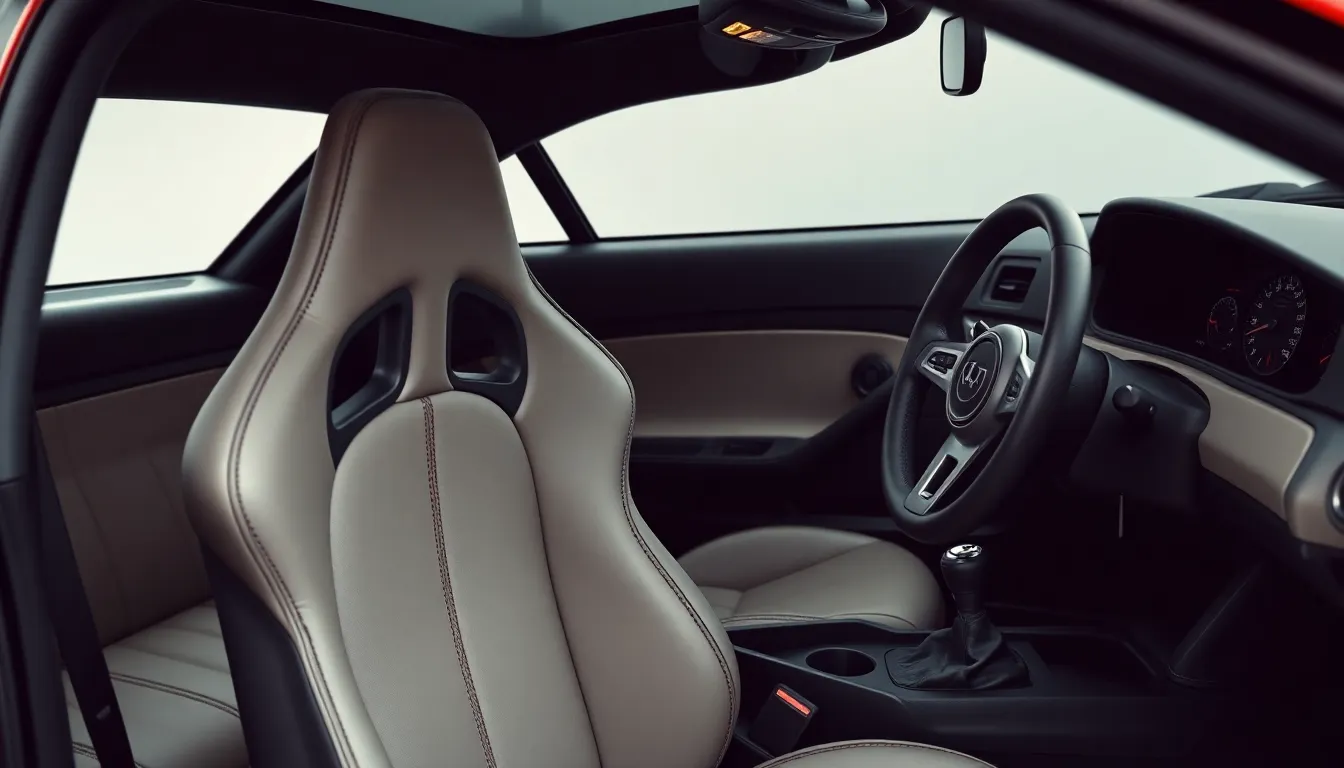
Interior aesthetics complete the authentic JDM experience by extending the minimalist philosophy from exterior design to the cabin space. Japanese manufacturers crafted interiors that prioritize functionality while maintaining visual harmony with their performance-oriented philosophy.
Minimalist Dashboard Layouts
Clean dashboard designs embody the Japanese principle of purposeful simplicity through uncluttered layouts and driver-focused ergonomics. We see this aesthetic most clearly in cars like the Honda NSX and Mazda RX-7, where every control serves a exact function without unnecessary decoration. Simple gauge clusters feature clear white backgrounds with precise markings that enhance readability during spirited driving sessions.
Functional button placement follows ergonomic principles that keep essential controls within easy reach of the driver’s position. Dashboard materials typically include matte black surfaces with subtle texturing that reduces glare and fingerprints. Center consoles maintain geometric shapes that complement the exterior design language while housing only essential climate and audio controls.
Digital displays in authentic JDM cars remain purposefully basic, showing vital information without overwhelming the driver with excessive graphics. Factory interiors often feature asymmetrical layouts that create visual interest while maintaining the clean aesthetic philosophy. Weight reduction considerations influenced many dashboard designs, leading to the removal of non-essential trim pieces and sound deadening materials.
Bucket Seats and Racing Harnesses
Sport seats represent the most visible connection between street cars and their racing heritage through aggressive bolstering and lightweight construction. Recaro buckets dominated many high-performance JDM models like the Subaru WRX STi and Mitsubishi Evo, featuring deep side bolsters that hold drivers securely during cornering. These seats often came in distinctive fabrics with geometric patterns or contrasting stitching that added visual interest to the cabin.
Racing harnesses became popular modifications that enhanced both safety and aesthetic appeal in track-focused builds. Four-point and six-point harness systems create striking visual elements across the interior while providing superior occupant protection compared to standard seatbelts. Harness bars or roll cages often accompany these installations, adding structural rigidity and racing authenticity to the overall package.
Seat materials vary from alcantara inserts to full leather options, with many enthusiasts preferring the grippy texture of suede-like fabrics. Color combinations typically follow the exterior paint scheme, with Championship White cars featuring black seats with white stitching details. Weight savings motivate many builders to replace heavy factory seats with lightweight racing buckets that can reduce overall vehicle weight by 50-100 pounds.
OEM+ Interior Modifications
Subtle interior upgrades maintain the factory aesthetic while improving quality and performance characteristics through carefully selected components. Shift knobs represent the most common OEM+ modification, with options ranging from weighted aluminum spheres to carbon fiber designs that match exterior accent pieces. Short shifter kits reduce throw distances while maintaining the precise feel that characterizes Japanese manual transmissions.
Steering wheels often receive attention through OEM upgrades like the Momo or Nardi options that came factory on certain models. These wheels feature smaller diameters and thicker grips that improve driving feedback while adding period-correct styling elements. Horn buttons typically display manufacturer logos or model designations that reinforce the car’s identity.
Interior trim pieces benefit from carbon fiber or aluminum replacements that reduce weight while adding visual texture to the cabin space. Door panels might receive alcantara inserts or carbon fiber accent pieces that complement the overall build theme. Pedal sets in aluminum or carbon fiber enhance the driving experience while maintaining the subtle approach that defines authentic JDM modifications.
Floor mats and other accessories follow the same restrained philosophy, with options like Mugen or STi branded pieces that add authenticity without overwhelming the clean interior aesthetic.
Engine Bay Aesthetics and JDM Styling

The engine bay represents the heart of JDM aesthetic philosophy, where mechanical precision meets visual artistry. We’ve discovered that authentic JDM builds treat the engine compartment as an extension of the car’s overall design language.
Color-Coded Components
Color coordination transforms mundane engine components into visual focal points that reflect Japanese attention to detail. We see this approach prominently in Honda’s Type R variants, where red valve covers create striking contrasts against Championship White paint schemes.
Factory color coding extends beyond valve covers to include intake manifolds, cam gears, and oil caps that match or complement the exterior paint. Nissan’s SR20DET engines often feature red or blue accents on turbocharger components and intercooler piping. Toyota’s 2JZ-GTE engines showcase silver and black anodized pieces that create sophisticated monochromatic themes.
Performance brands like Spoon Sports and Mugen established the precedent for color matched engine dress up parts in yellow, blue, and red finishes. These manufacturers understand that engine bay aesthetics should enhance rather than distract from the mechanical components’ inherent beauty. Modern JDM builds maintain this philosophy by selecting colors that complement both the exterior paint and the engine’s natural metallic tones.
Polished and Anodized Parts
Premium surface finishes elevate functional components into jewelry like automotive art pieces throughout the engine compartment. We observe this most clearly in authentic JDM builds where every visible surface receives careful attention to material quality and finish consistency.
Anodized aluminum parts dominate high end JDM engine builds, with manufacturers like HKS and Trust (GReddy) leading the way in premium surface treatments. Purple, blue, and red anodizing became signature colors for different performance brands during the 1990s tuning era. These finishes not only provide corrosion resistance but also create visual hierarchy within the engine bay.
| Component Type | Common Finishes | Notable Brands |
|---|---|---|
| Intercooler Piping | Polished Aluminum, Blue Anodized | HKS, Trust, Blitz |
| Intake Manifolds | Red, Black, or Natural Anodized | Skunk2, Injen, AEM |
| Cam Gears | Gold, Purple, Blue Anodized | Tomei, Brian Crower, Greddy |
| Oil Caps | Matching Brand Colors | Mugen, Spoon Sports, Type R |
Polished stainless steel components create mirror like reflections that add depth and dimension to engine compartments. Headers, exhaust manifolds, and turbo heat shields receive this treatment to maintain visual consistency. Japanese builders typically reserve chrome finishes for exact accent pieces rather than applying them broadly across multiple components.
Clean Wire Management
Professional wire routing separates authentic JDM builds from amateur modifications through systematic organization of electrical components. We recognize that Japanese manufacturers pioneered clean wire management techniques that prioritize both functionality and visual appeal.
Factory JDM engines demonstrate proper wire management through integrated clips, looms, and routing channels that follow natural component lines. Honda’s Type R engines showcase this approach with color coordinated wire looms that match valve cover accents. Nissan’s RB and SR series engines feature systematic wire routing that maintains accessibility while creating organized visual patterns.
Aftermarket wire management answers include split loom tubing, heat shrink, and custom wire tucks that relocate unsightly connections behind engine components. Performance shops like Option Magazine featured builds often showcase engines where every wire disappears from view through careful planning and execution. This approach requires understanding both electrical function and visual flow to achieve authentic results.
Custom wire harnesses allow builders to eliminate excess wiring length while maintaining proper electrical connections throughout the engine bay. Professional JDM builds integrate these harnesses with existing factory routing to preserve the manufacturer’s intended aesthetic while accommodating performance modifications.
Modern Interpretations of Classic JDM Cars Aesthetic
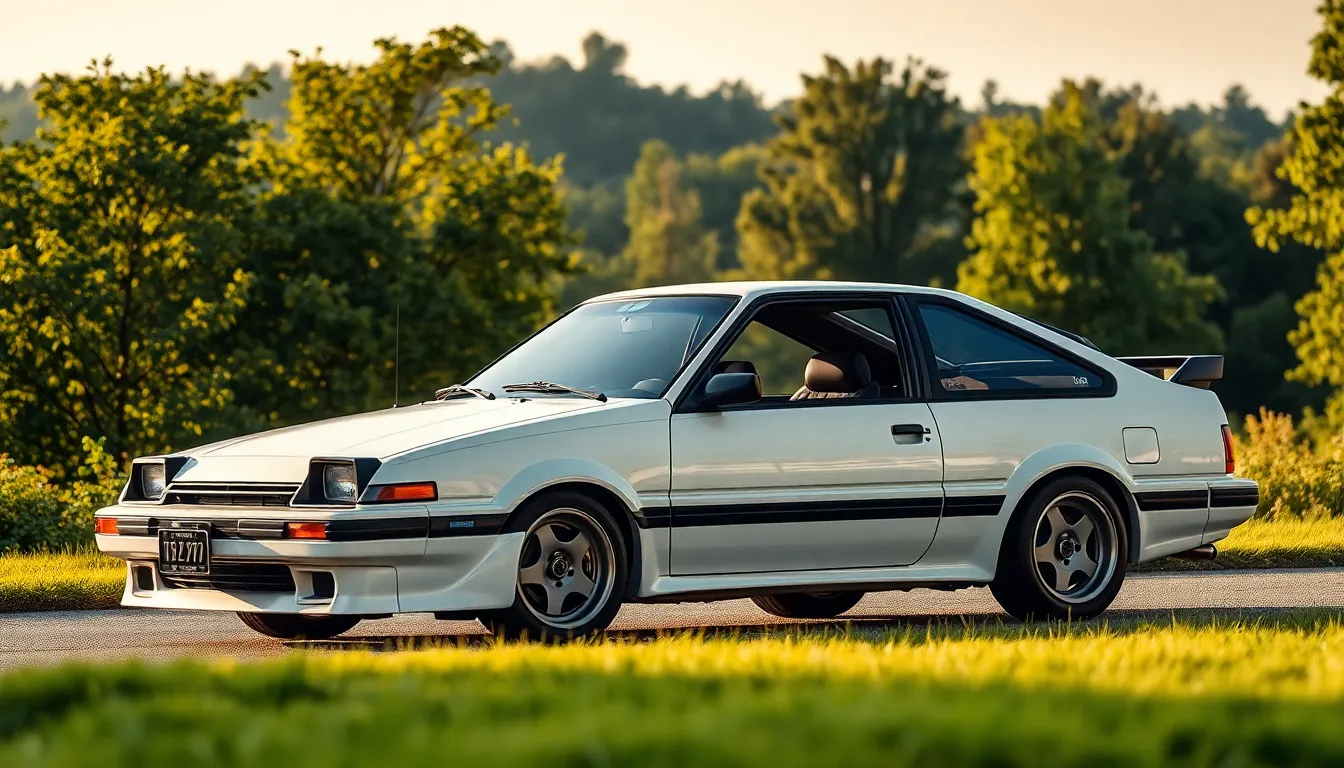
Today’s builders continue to evolve the JDM aesthetic through innovative approaches that honor traditional principles while embracing contemporary possibilities. Modern interpretations demonstrate how timeless Japanese design philosophy adapts to current trends and technology.
Resto-Mod Approaches
Resto-mod builds blend original JDM DNA with modern performance capabilities. We see builders maintaining classic exterior proportions while integrating contemporary suspension systems, braking components, and engine management technology. Popular projects include Toyota AE86 builds featuring modern coilover systems paired with period-correct TE37 wheels, creating vehicles that look authentic but perform beyond original specifications.
Engine swaps represent the most dramatic resto-mod transformations. Honda K-series engines find their way into classic Civic hatches, while LS swaps breathe new life into Nissan 240SX chassis. These modifications maintain visual authenticity through careful component selection and color matching, ensuring modern powerplants complement rather than clash with traditional JDM styling cues.
Interior updates focus on improving usability without compromising character. Builders integrate modern audio systems, climate control, and safety equipment while preserving original dashboard layouts and control placement. Popular modifications include hidden stereo installations, upgraded HVAC systems, and period-appropriate gauge clusters with modern internals.
Contemporary Builds with Vintage Elements
Modern chassis receive vintage JDM styling treatments through careful part selection. We observe enthusiasts applying classic design elements like ducktail spoilers, flared fenders, and traditional wheel choices to contemporary platforms. Current generation Honda Civic Type R builds often incorporate vintage Mugen aero pieces, creating connections between past and present performance aesthetics.
Wheel choices bridge generational gaps in JDM culture. Classic designs from Work, Rays, and Enkei continue production specifically for modern fitments, allowing builders to achieve authentic looks on contemporary vehicles. Popular combinations include Work Meister S1 wheels on modern WRX STI builds and Volk TE37 designs adapted for current BMW and Mercedes platforms embracing JDM influences.
Color palette applications maintain authenticity across generations. Championship White, Midnight Purple variations, and classic racing reds appear on modern builds, connecting new vehicles to established JDM heritage. Paint choices often include period-appropriate finishes like single-stage applications on contemporary bodywork, creating visual links to vintage Japanese performance cars.
Social Media Influence on JDM Styling
Instagram and TikTok drive rapid evolution of JDM aesthetic interpretations. We track how social media platforms accelerate trend cycles, with exact modifications gaining popularity through viral content and influencer features. Hashtags like #JDMCulture and #StanceNation generate millions of views, exposing wider audiences to authentic JDM styling principles.
Photography aesthetics shape how builders approach their projects. Static shots emphasizing wheel fitment, rolling footage highlighting suspension travel, and detail photography focusing on engine bay components influence modification priorities. Builders increasingly consider how their vehicles will appear in social media content, leading to more photogenic builds that maintain authentic JDM characteristics.
Global communities share techniques and inspiration through digital platforms. We see Japanese tuning shops connecting directly with international builders, sharing authentic modification approaches and product recommendations. Social media enables real-time exchange of styling ideas, parts sourcing information, and technical knowledge that previously required magazine publications or physical events to disseminate.
Trend acceleration creates both opportunities and challenges for authentic styling. Popular social media content can elevate quality builds while also promoting superficial modifications that prioritize visual impact over functional purpose. Experienced builders use these platforms to educate newcomers about authentic JDM principles, helping maintain traditional standards while embracing modern communication methods.
Building Your Own JDM Cars Aesthetic
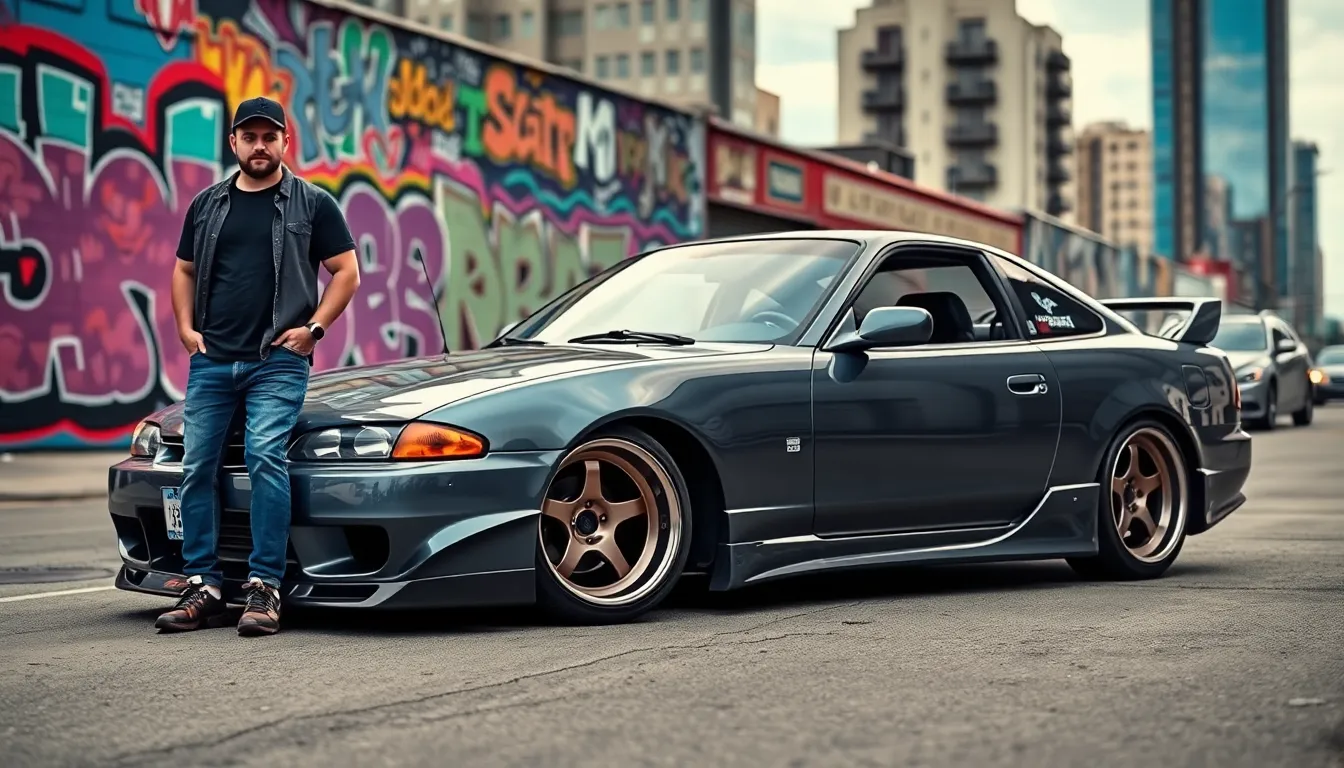
Creating an authentic JDM build requires strategic planning and understanding of what separates genuine Japanese domestic market styling from superficial imitations.
Choosing the Right Base Vehicle
Popular chassis selection forms the foundation of any successful JDM aesthetic build. We recommend starting with iconic platforms like the Nissan 240SX, Honda Civic EK/EG, Toyota AE86, or Mazda Miata NA/NB for their proven modification potential and authentic JDM heritage.
Research the vehicle’s original specifications before making purchase decisions. Factory features like sunroofs, limited slip differentials, and sport packages significantly impact both authenticity and resale value in JDM builds.
Consider your skill level and budget when selecting between project conditions. Rolling shells offer maximum customization freedom but require extensive mechanical knowledge, while running examples provide immediate enjoyment with gradual modification potential.
Verify chassis codes and production origins to ensure authenticity. Japanese market vehicles carry exact chassis codes that distinguish them from USDM counterparts, affecting both parts compatibility and community recognition.
Essential Modification Priorities
Suspension setup takes precedence over cosmetic modifications in authentic JDM builds. Quality coilover systems from brands like Tein, HKS, or Cusco provide the foundation for proper stance and handling characteristics that define the aesthetic.
Wheel selection dramatically transforms the visual impact while serving functional purposes. Japanese brands like Work Emotion, Rays TE37, or Enkei RPF1 offer the geometric designs and lightweight construction that complement JDM styling principles.
Brake system upgrades enhance both performance and visual appeal through larger rotors and colorful calipers. Brands like Brembo, Endless, or Project Mu provide the stopping power while adding authentic racing heritage touches.
Engine bay cleaning and organization creates the mechanical precision that distinguishes professional builds. Color coded components, polished intake pipes, and systematic wire management reflect the attention to detail found in genuine JDM vehicles.
Aerodynamic elements should serve functional purposes rather than purely aesthetic ones. Front splitters, side skirts, and rear spoilers from companies like Spoon Sports or Mugen provide downforce while maintaining the purposeful design philosophy.
Balancing Authenticity with Personal Style
Respect the original design language while incorporating personal touches through subtle modifications. Authentic JDM builds maintain the manufacturer’s intended proportions and character lines even when adding aftermarket components.
Research period correct modifications that were available during the vehicle’s original production era. Parts catalogs from the 1990s and early 2000s provide inspiration for modifications that enhance rather than compromise the original aesthetic.
Quality over quantity guides successful personalization decisions. We suggest choosing fewer, higher quality modifications rather than accumulating many inexpensive parts that dilute the overall impact.
Document your build process through photos and parts lists to track authenticity and share knowledge with the community. Social media platforms allow builders to connect with others pursuing similar aesthetic goals while learning from experienced enthusiasts.
Maintain reversibility when possible by keeping original parts for future restoration or resale considerations. This approach preserves the vehicle’s heritage while allowing experimentation with different styling directions.
Conclusion
The JDM aesthetic remains one of automotive culture’s most enduring and influential movements. We’ve seen how this philosophy transforms simple modifications into purposeful expressions of engineering excellence and visual harmony.
What sets authentic JDM builds apart isn’t just their iconic visual elements—it’s the unwavering commitment to balance. Every component serves both form and function while respecting the vehicle’s original DNA.
As we move forward the core principles of JDM styling continue to inspire new generations of builders. The emphasis on quality craftsmanship and functional beauty ensures this aesthetic will remain relevant for years to come.
Whether you’re planning your first build or refining an existing project remember that true JDM style comes from understanding the philosophy behind the modifications. It’s this depth of knowledge that separates authentic builds from simple imitations.
Frequently Asked Questions
What makes JDM aesthetic different from other car styling approaches?
JDM aesthetic emphasizes the harmony between form and function, rooted in Japan’s kaizen philosophy of continuous improvement. Unlike flashy modifications, authentic JDM styling prioritizes clean lines, purposeful design elements, and minimalist principles where every aesthetic feature serves a practical purpose, creating vehicles that balance visual appeal with performance functionality.
Which body styles are most iconic in JDM culture?
The three defining JDM body styles are lightweight sports coupes (like Toyota AE86 and Nissan 240SX), compact hot hatches (Honda Civic and Subaru WRX STi), and sleek sedan silhouettes (Nissan Skyline GT-R and Toyota Crown). Each style combines everyday practicality with performance-oriented design elements and distinctive visual characteristics.
What are the most important visual elements of JDM design?
Key JDM visual elements include clean geometric lines, angular bodywork, functional aerodynamic components like front splitters and rear spoilers, and iconic features such as pop-up headlights. These elements prioritize geometric precision and serve both aesthetic and performance purposes, distinguishing authentic JDM builds from superficial modifications.
Which wheel brands and stance modifications define JDM culture?
Classic Japanese wheel brands like Work, Rays Engineering, and Enkei are fundamental to JDM culture. Essential stance modifications include coilover suspension systems, aggressive camber angles, and precise wheel fitment. These modifications create the distinctive lowered appearance and performance-oriented stance associated with authentic JDM builds.
What are the signature JDM paint colors and schemes?
Iconic JDM colors include Championship White (popularized by Honda NSX-R), Racing Red for high-performance variants, and unique shades like Midnight Purple II. Pearl and metallic finishes add depth, while two-tone paint schemes highlight design elements and draw inspiration from motorsport liveries, maintaining authentic styling principles.
How do JDM interiors reflect the overall design philosophy?
JDM interiors extend the minimalist philosophy with clean dashboard layouts prioritizing driver ergonomics and functionality. They feature sport seats, racing harnesses connecting to motorsport heritage, and OEM+ modifications that enhance quality while maintaining the factory aesthetic. Every element focuses on usability and attention to detail.
What should beginners focus on when building an authentic JDM car?
Start with selecting the right base vehicle like a Nissan 240SX or Honda Civic, then prioritize suspension setup, quality wheel selection, and brake system upgrades. Focus on period-correct modifications, maintain mechanical precision, and balance authenticity with personal style while documenting the build process for future reference.
How has social media influenced modern JDM culture?
Social media platforms like Instagram and TikTok have accelerated trend cycles and created global communities for sharing techniques and inspiration. However, they’ve also led to challenges with superficial modifications that prioritize visual impact over functional purpose, sometimes diluting authentic JDM principles in favor of social media appeal.

